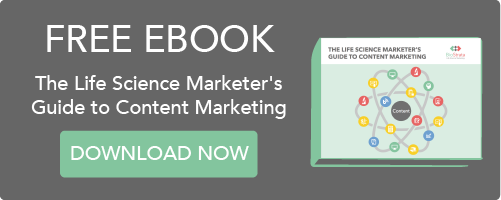
Working for a life science company can be extremely rewarding, given that your company produces technology that’s literally changing the world and making it a better place – whether in healthcare, research or agricultural sectors. That said, it can be tricky to translate this into an effective marketing strategy with sound messaging about the backbone of your company’s offerings, scientific approach and technology.
Marketers in life science companies have the dual challenge of differentiating themselves from competitors on a technical level while simultaneously shedding the stigma of being bland and inaccessible.
So how do you communicate the right context while portraying your company as knowledgeable, trendy, and self-aware enough to warrant attention? Simple – you convey how your company brings positive change to the world by supporting science, healthcare or industry and demonstrate why your target audience should take notice. Content marketing is the perfect marketing strategy for this, as it's versatile and universally applicable enough for even the most esoteric of life science companies.
Here are some tips to make content marketing work for every brand, no matter your industry:
Focus on what’s important to your customers.
One of the main aspects of content marketing that truly sets it apart from more traditional marketing methods is how it places your customer at the centre of everything you do. Every for-profit organisation has a target market comprised of key decision makers – from biotech, agrichem and contract service companies, to B2B software companies, to the kebab shop down the street. As such, your marketing content should speak to the specific needs and wants of these decision makers. Content marketing does exactly that through extensive market research and a compiling of distinct marketing personas – semi-fictional representations of your target buyers that address professional capacity, decision-making process and pain points, as well as more personal characteristics like ambitions and day-to-day frustrations. Content written with a distinct reader in mind will be a lot more effective at communicating with them effectively and resonating on a deeper level.
This customer-centric approach calls for a far broader approach to content than simply writing about your products or services. Instead, you should talk about your customers – their issues, concerns and excitements. Then, once you’ve drawn attention to a problem of theirs from a place of empathy, you’re in the ideal position to offer a solution: your offering. People don’t want to always be sold to, so they need to gain value from reading your article. Make it worth their while by doing thorough research, speaking their language and telling them something new.
Stay curious, and remember you are talking to humans.
Curiosity is at the core of all scientific enquiry and – dead cats aside (and without even mentioning Schrödinger) – it is a key ingredient to an effective content marketing strategy. This is especially true for life science companies whose target personas are generally more niche and specialised in their professional and private interests. To write interesting and enticing content for these personas, it’ll do a world of difference to foster a genuine curiosity for their respective industries. Content that inspires, engages and informs will stick with your reader, making them more likely to remember your company when they have to make critical purchasing decisions. Never forget that you’re writing for people, each with their own egos, ambitions, annoyances and goals. You actually have more in common with your target reader than you might think – we’re all just human after all.
Tap into the expertise of your team.
Life science companies have a distinct advantage over many other industries when it comes to the sheer level and diversity of the expertise residing within their people. Where else is it commonplace for a marketer and business development specialist to have lunch (or a cringeworthy watercooler conversation) with a molecular biologist and environmental engineer? Everyone in your organisation is a potential source of information for your marketing content, giving it the quality boost it needs to engage target readers and earn their respect and interest. Your product and application specialists, business development team and support teams will have detailed knowledge about what your customers are trying to achieve, and should be able to guide your content creation strategy for maximal effectiveness. They likely have a wealth of experience in the scientific area of interest themselves, so could be a valuable source of insight for fuelling your content generation efforts.
Companies that are actively helping to improve the world people live in should have a field day with content creation, as they have so much more to share with a world of unsuspecting individuals. Tutorials, buying guides, humorous videos and product demos are all simple yet effective strategies that can be used in any industry. And yes, even life science companies can achieve high levels of success with content marketing – given the right strategy.
Download our free Content Marketing Guide to learn more.




